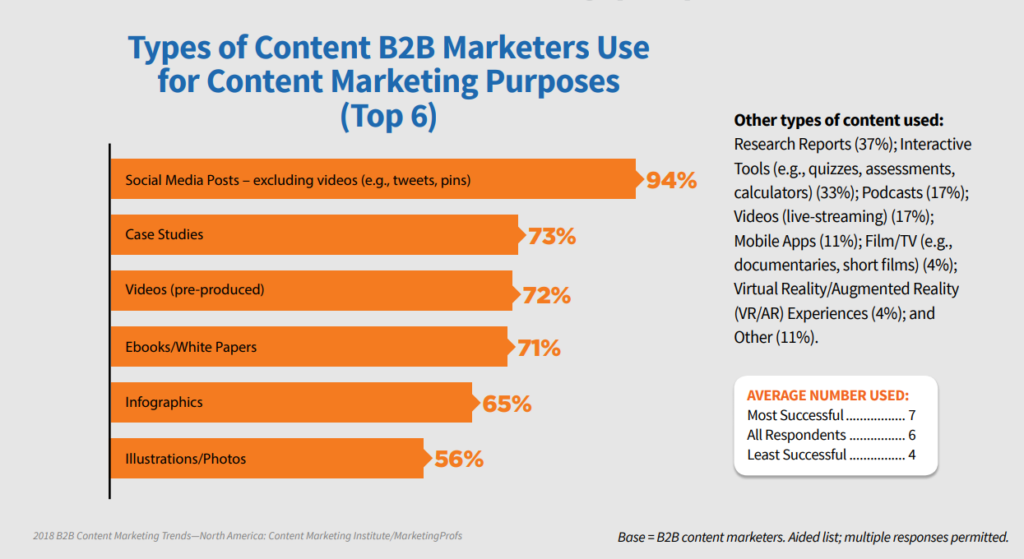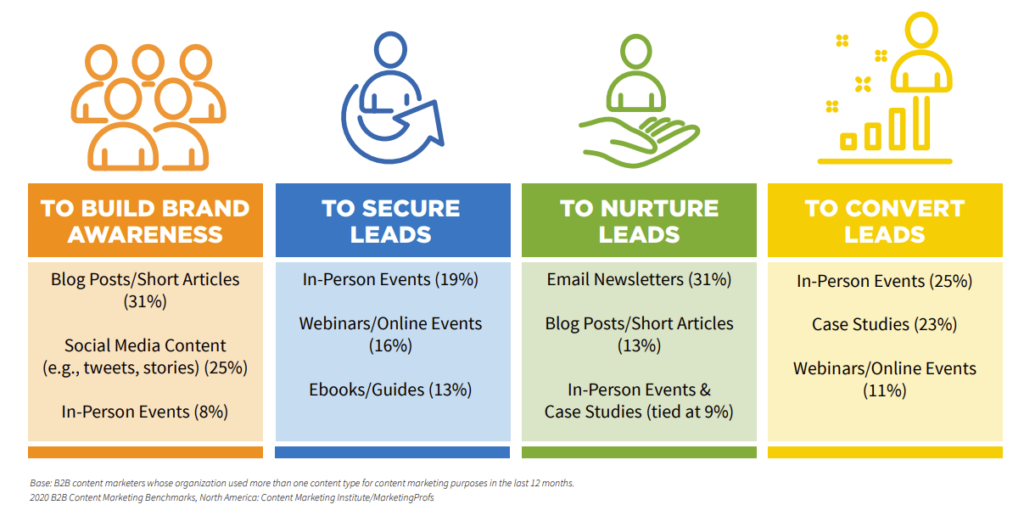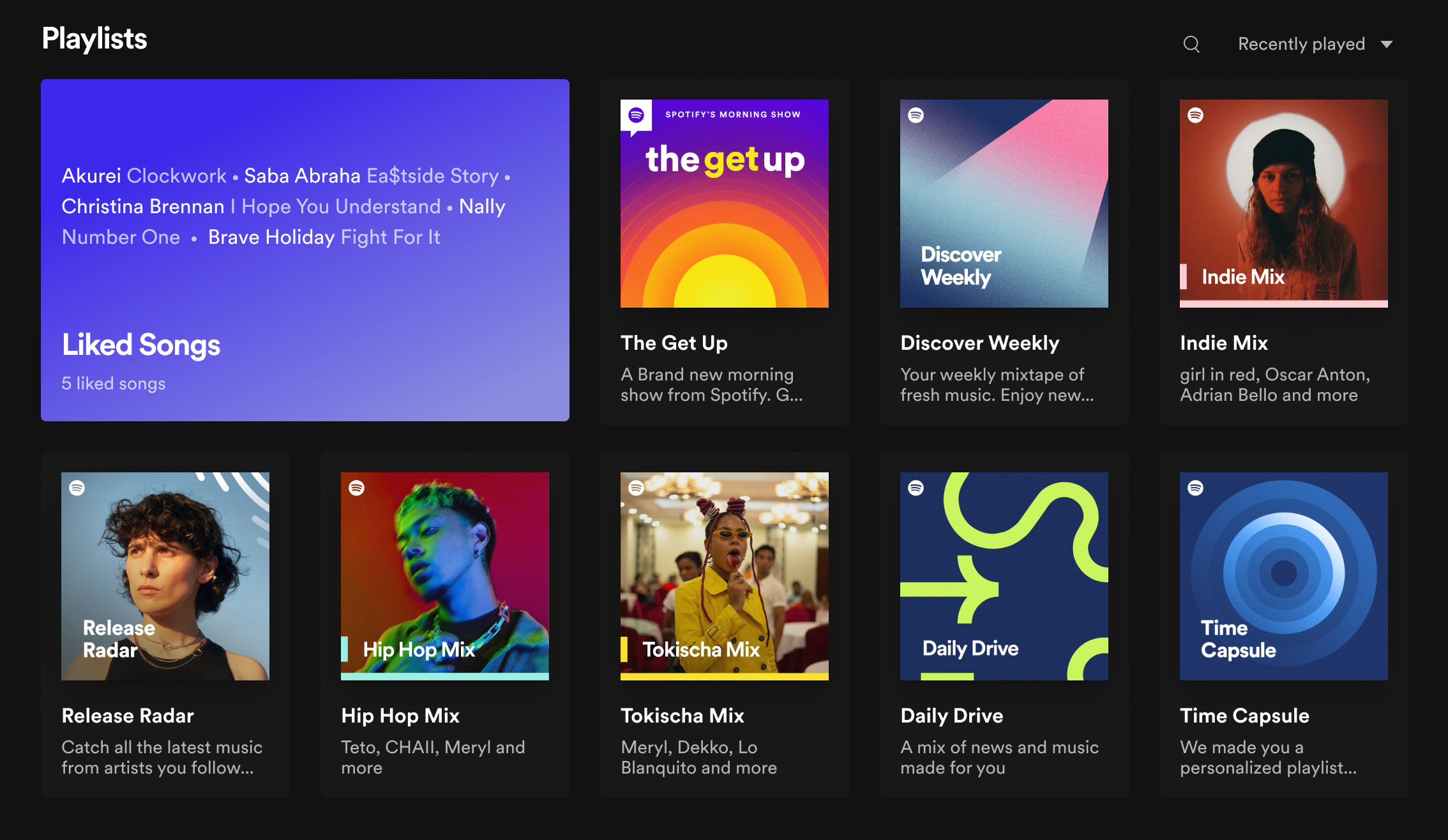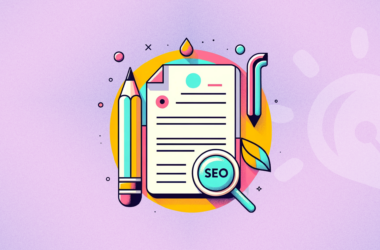Last updated on December 14th, 2023
If you’ve been around the content arena for a long, you must have come across Hubspot’s blogs. Their content is propelled by customer-centric, value-driven content that fosters a loyal customer base.
They don’t just sell products; they sell values, insights, and solutions, crafting a narrative that puts the customer at the heart of every story. In B2B content creation, the stories you craft and disseminate have a remarkable potential to linger in the minds of your audience.
- It influences perceptions.
- It drives actions long after the initial encounter.
- It converts prospects into clients and loyal advocates.
But crafting a narrative that sticks requires carefully curated B2B content marketing strategies that are grounded in understanding your audience’s psyche.
In this piece, we unravel the art and science of creating B2B content marketing strategies that not only stick but convert.
What is a B2B content marketing strategy?

B2B content marketing strategies guide businesses in creating and distributing valuable content to attract a defined target audience.
The goal is straightforward:
Deliver content that solves problems, offers insights, and fosters trust. It should encourage potential clients to choose your services over others.
It’s about being a reliable voice in your sector, constantly offering value, and building a relationship grounded in reliability.
Difference Between B2B Content Marketing Strategy and B2C
B2B and B2C content marketing strategies share the same fundamental principle of leveraging content to build relationships and drive sales. But they cater to distinctly different audiences with different needs and buying processes. The strategies diverge notably in their approach, tone, and content type.
| Factors | B2B | B2C |
| Audience | Businesses, decision-makers | Individual consumers |
| Buying Cycle | Longer, often involving multiple stages | Shorter, more impulsive |
| Messaging | Professional, focused on ROI and problem-solving | Emotional, aspirational, centred on personal benefits |
| Goal | Lead generation, nurturing long-term relationships | Immediate sales, cultivating brand loyalty |
Why Do You Need Content Marketing Strategy For B2B?

Well-planned B2B content marketing strategies facilitate a structured approach to presenting your business’s value proposition. Here’s what it brings to the table:
- Visibility: Standing out in a crowded market.
- Trust: Building and nurturing confidence in your brand.
- Education: Informing potential clients about your services, USP.
- Reach: Enhancing search engine rankings and drawing organic traffic.
- Lead Generation: Attracting and converting high-quality leads.
- Cost-Effectiveness: Offering a higher ROI compared to traditional marketing methods.
- Customer Retention: Encouraging repeat business through continuous engagement.
Types of B2B Marketing
What’s the secret sauce to winning at B2B marketing? It starts with identifying the type of marketing approach you want to leverage. These include:
1. Content Marketing
Businesses utilise blogs, white papers, webinars, case studies, etc., to showcase their expertise and provide solutions to their audience’s challenges. It is all about creating valuable and relevant content to attract a defined audience.
Example: A SaaS company running a series of webinars to educate potential clients on optimising business processes using their software.
2. Email Marketing
Email marketing involves sending targeted emails to nurture leads and foster relationships with potential clients. Regular newsletters, product updates, and industry insights are common content types in B2B email marketing.
Example: A manufacturing company sending monthly newsletters featuring insights on industry trends and showcasing their latest products.
3. Social Media Marketing
Even in B2B, social media platforms are essential in nurturing relationships. Platforms like LinkedIn are hubs for B2B engagements. It enables professional connections and allows you to share industry knowledge through posts, articles, and even videos.
Example: A consultancy firm sharing bite-sized tips and success stories on their LinkedIn page to engage potential business clients.
4. SEO Marketing
SEO in the B2B space involves optimising your website and content to rank higher in search engine results, thereby increasing visibility and attracting organic traffic. It involves keyword optimisation, creating quality content, and building backlinks.
Example: An IT solutions provider optimising their blog posts with relevant keywords to attract businesses looking for IT solutions on search engines.
How To Develop Winning B2B Content Marketing Strategies
Astoundingly, while 40% of B2B marketers have a documented content marketing strategy, 27% are operating without any strategy at all. Despite the pandemic escalating content usage by a monumental 207%, only 54% of marketers are taking a step further to analyse their content ROI in 2023.
This presents both a challenge and an opportunity for businesses. Having robust and well-articulated B2B content marketing strategies can be your golden ticket to standing tall in a competitive industry landscape. Let’s look at the nuances of developing a content marketing strategy for B2B.
1. Define Your B2B Content Marketing Strategy’s Goals
Dive into setting SMART goals — Specific, Measurable, Achievable, Relevant, and Time-bound targets to streamline your objectives clearly and practically. Here’s how it works:
- Specific: Hone in on what exactly you want to achieve.
- Measurable: Ensure you can track and quantify your success.
- Achievable: Set targets that are challenging yet attainable.
- Relevant: Align goals with your business objectives and audience needs.
- Time-bound: Attach a clear timeframe to each goal to foster urgency and focus.
Here are some real-world examples of SMART goal setting:
- Aiming to secure 50 fresh leads through your content marketing strategies from January 1 to March 31.
- Boost engagement on our LinkedIn posts to a consistent 1000 interactions per post by Q2 end.
- Increase blog traffic by 30% through organic search by the close of the fiscal year.
Remember, embarking on the goal-setting journey isn’t a linear process. You will need to iterate your goals and refine them based on insights garnered along the way.
2. Understanding The Target Market & Audience: Develop your buyer personas
Take a step back to understand the audience you are serving. Start with creating buyer personas.
These are semi-fictional representations of your ideal customers, built based on real data and market research. Let’s say you are targeting decision-makers at companies who are responsible for purchasing a SaaS solution to improve their team’s productivity. Here’s a potential buyer persona for the same:
| Aspect | Details |
| Persona Name | Ethan, Efficiency Expert |
| Age | 35-45 years old |
| Job Title | Chief Operations Officer (COO) |
| Industry | Various industries (Finance, Healthcare, IT services) |
| Education | Master’s degree in Business Administration or related field |
| Goals | To streamline operations, enhance team productivity, and improve ROI |
| Challenges | Finding a reliable, user-friendly, and cost-effective SaaS solution |
| Pain Points | Wasted time due to inefficient tools, difficulty in tracking team productivity |
| Decision-making Factors | Ease of integration with existing systems, customer support, positive reviews |
| Communication Channels | LinkedIn, industry webinars, trade journals |
3. Understand Where Your Users Are in The Buyer’s Journey

A typical B2B buyer journey involves three distinct phases: awareness, consideration, and decision. Here we’ve mapped out the types of user behaviour and different content types that resonate well at each stage.
| Stage | User Behaviour | Content-Type |
| Awareness | Seeking information on the identified issue | Blogs, ebooks, educational webinars |
| Consideration | Researching potential solutions | Solution guides, comparison charts, expert webinars |
| Decision | Ready to purchase or engage further | Case studies, product demos, free trials |
4. Determine your Brand Voice and Tone
Mailchimp has done an excellent job at determining the tone and voice for their content marketing strategy: Check here.
The voice and tone will be the backbone of your brand’s personality. It needs to be consistent in every piece you churn out.
- Start with identifying your voice, which remains consistent across all your marketing avenues.
- Describe it using adjectives such as “funny,” “warm,” or “edgy”.
- Carve out the tone — the style that manifests in individual content pieces. Make sure this is influenced by the buyer persona you are targeting.
For example, when you’re targeting high-level professionals such as product leaders or VPs for selling a CRM tool, your tone should be professional yet dynamic to cater to their sophisticated tastes and busy schedules. Here’s how you can structure your brand voice and style for VP or product leaders from a B2B organisation in different scenarios:
| Content-Type | Voice | Tone | Example |
| Blog Posts | Professional | Informative yet engaging | “Leveraging CRM to Drive Product Innovations: A Guide for Leaders” |
| Email Campaigns | Professional | Direct and personal | “Exclusive Insights on CRM Enhancements Await You, [First Name]” |
| Social Media | Professional | Friendly and insightful | ” Discover the CRM tool that VPs swear by! #ProductLeadership” |
| Whitepapers | Professional | Detailed and authoritative | “In-depth Analysis: How CRM is Shaping the Future of Product Leadership” |
| Webinars | Professional | Engaging and educational | “Join Our Expert Panel Discussing CRM Innovations for Product Leaders” |
In each content type, the voice remains professional, representing a knowledgeable and reliable brand. However, the tone varies, ranging from:
- Informative and engaging in blog posts
- Direct and personal email campaigns
- A friendly vibe on social media
- A detailed and authoritative note in whitepapers
- Engaging yet educational demeanour in webinars
5. Strategising Content Ideas and Identifying Ideal Content Types
It’s pivotal to outline channels, brainstorm fresh content ideas, and allocate them appropriately to optimise reach and engagement. Here is how you can go about it:
I. Determine your channels
Identify where your audience spends most of their time and focus your efforts there.
Consider platforms that not only align with your content type but also harbor your target demographic. You can leverage analytics tools to understand user behaviour and preferences.
II. Think about content ideas
This includes:
- Investigating competitors’ best-performing content pieces
- Monitoring keyword rankings of industry leaders
- And tapping into what your users would like to read and at what stage
III. Determine what idea goes where and in which format
Match the content format with the consumption behaviour typical to a platform. For instance, infographics work great on platforms like Pinterest and Instagram.
Whether it’s a detailed blog post for your website to nurture SEO, an engaging video for social media, or a persuasive infographic for an email campaign, mapping content ideas to the right outlets can enhance their impact manifold.
B2B Content Marketing Strategies in Action: Map A Clear Plan Before You Begin
Always keep your buyer personas in mind to create content that nurtures and retains users/customers. Here’s an example of how (and what type) you can create content for each stage in the buyer’s journey.
| Funnel Stage | Content-Type | Content Idea |
| Awareness | Blog Posts | “Top 10 Industry Innovations in 2023” |
| Consideration | eBooks | “A Comprehensive Guide to Choosing the Right [Your Product/Service]” |
| Decision | Case Studies | “How Company X Increased Efficiency by 50% Using [Your Product/Service]” |
| Retention | Newsletters | “Monthly Tips and Tricks to Get the Most Out of [Your Product/Service]” |
| Advocacy | Referral Programs | “Refer a Friend and Get Exclusive Benefits” |
6. Execute Your B2B Content Marketing Strategies
Success in content hinges largely on a well-documented content marketing strategy. Start by creating a comprehensive document accessible to your entire team.
This should include details about your goals, buyer personas, content ideas, and other critical components of your strategy. Below, we have outlined the essentials of your execution strategy for effective implementation:
I. Documentation
Create a Central Document
- Purpose: To maintain uniformity in communication and strategy
- Tools: Word document, Google Sheets, Evernote
- Access: Ensure company-wide accessibility
Map an Editorial Calendar
- Frequency: Monthly/Quarterly/Yearly (Recommended: Quarterly)
- Components of an Editorial Calendar:
| Feature | Description |
| Topic/Title | Define the focus of the content |
| Target Keywords | Identify SEO-centric keywords |
| Target Persona | Specify the audience demographic |
| Publish Date | Set a tentative release date |
| Offer/CTA | Detail the call to action |
| Writer | Assign a writer |
II. Execution
As you venture into the execution phase, maintaining consistency is key. Leverage project management tools such as Trello or Asana to keep track of tasks and ensure team accountability. Regular meetings to review responsibilities and priorities can be instrumental in steering the team toward the set goals.
Tips for Consistent Execution
- Set Clear Deadlines: Establish priority and track progress
- Avoid Overloading: Start with high-priority tasks, avoid taking on too much at once
- Feedback Loop: Remain open to necessary adjustments based on real-time feedback
- Highlight Task Importance: Communicate the relevance of each task to the team
Remain adaptable and keep making necessary adjustments to your B2B content marketing strategies based on real-time feedback and performances.
When the workload seems overwhelming, you can also think of reaching out to experienced agencies like Wittypen to help you stay on course. Leveraging their expertise to optimise your content marketing strategy while alleviating many of your burdens.
B2B Marketing Trends to Watch in 2023
As we steer further into 2023 amidst a backdrop of economic uncertainties and evolving consumer preferences moulded by “the new normal,” it becomes imperative to remain alert to the shifting trends in the B2B marketing landscape. Here are some predominant trends that are expected to characterise the sector in 2023:
1. Personalisation Remains Paramount
Targeted content and personalised messaging will be pivotal for B2B companies in the coming years. This is because companies are keen to understand their audience’s unique preferences to tailor content and experiences precisely. Spotify’s Marketing stands as a testament to the potency of personalisation.

Its features ‘Discover Weekly’ and ‘Daily Mix’ curate music based on individual user behaviours. This showcases the brand’s proficiency in utilising data to enhance the user experience.
2. Increased Reliance on AI and Automation, with Responsible Oversight
2023 is seeing businesses lean more on AI and automation, and here’s why it’s trending: these tools are your ticket to efficient and targeted marketing campaigns. But it’s not just about automation; it’s about smart and ethical automation.
Picture this – using Salesforce’s AI tool, Einstein, you can zoom in on your customer’s behaviour, predicting their future moves. But remember, keeping it ethical and transparent is non-negotiable. It’s all about striking the right balance to foster trust and efficiency.
3. Customer Experience as a Focal Point
Happy customers stick around. If you’re in B2B, it’s time to roll up those sleeves and carve out a customer journey that feels personal and seamless. Think tools that let you tune into what your customers really want, just like what Adobe is rocking at.
Step into your customer’s shoes, get the full picture, and deliver experiences that not just satisfy but delight. It’s your golden ticket to building loyalty and scoring repeat business.
Harnessing Success Through Strategic B2B Content Strategy
Building successful B2B content marketing strategies necessitates collaborative input from every department. Despite the initial extensive effort, developing distinct personas, defining brand voice and tone, and establishing a documented strategy prove invaluable.
Acting as a roadmap, it unifies the team under a shared vision, facilitating smoother progress. Undertake it step by step to seamlessly weave B2B content marketing strategies that stand robust, fostering business growth.
But why traverse this path alone? Wittypen is your companion in this endeavour, bringing to the table AI-powered tools and a network of professional writers to help you accelerate the content creation process with a seal of quality and originality.
Dive deeper into the secrets of successful B2B content marketing with Wittypen’s seasoned expertise. Let’s work hand in hand to create content loved by your readers, content that drives revenue.
FAQs
1. What are the key elements of a successful B2B content marketing strategy?
Winning B2B content marketing strategies hinges on clearly defined goals, understanding your audience, consistent and quality content production, SEO optimisation, and meticulous performance analysis to refine strategies continually.
2. How can I identify and understand my B2B target audience?
Kickstart by researching your current customer base, and exploring industry reports and surveys. Develop buyer personas to outline the typical needs, challenges, and behaviours of potential clients.
3. What types of content work best for B2B audiences?
Educational and insightful content like white papers, case studies, and webinars typically resonate well with B2B audiences. These contents provide value and solve specific problems, thereby nurturing trust and expertise.
4. What metrics should I track to measure the success of my B2B content marketing strategies?
Focus on metrics such as lead quality, website traffic, SEO rankings, and engagement rates on different platforms to get a holistic view of your B2B content marketing strategy’s effectiveness.
5. Which tools can help me monitor and analyse the performance of my B2B content?
Leverage tools like Google Analytics for tracking website performance, SEMrush for SEO analysis, and HubSpot for comprehensive content marketing analysis to stay on top of your B2B content’s performance.









